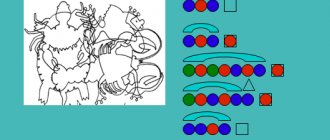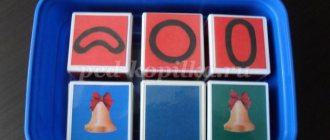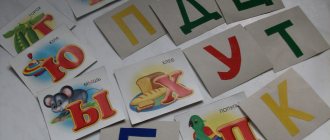“Differentiation of wild and domestic animals”
Section “Formation of lexical and grammatical categories.”
Goals:
1. Consolidate and clarify knowledge about domestic and wild animals, and activate children’s vocabulary on the topic.
2. Continue learning to form possessive adjectives from a noun.
3. To consolidate the formation of the genitive case of a noun in the singular.
4. Strengthen the agreement of the noun with possessive pronouns, with the numerals 2, 5.
5. Reinforce the use of the preposition “BECAUSE”
6. Strengthen the ability to select adjectives and present tense verbs for nouns.
7. Develop visual, auditory attention, memory, logical thinking.
Equipment: pictures of wild, domestic animals and their cubs, magnetic board, easel, subject pictures on the topic, cut-out pictures, tray, numbers 2, 5, numbered envelopes with tasks, medals for children, prizes for children.
"Wild and Domestic Animals"
1. Introduction to the situation.
Didactic tasks: Motivate children to engage in gaming activities.
In the morning, when children enter the group, they see animal toys (cat, dog, wolf, fox, hare, bear, cow, sheep, etc.). They ask the teacher why we have so many animals? Where are they from?
Educator: These animals were given to us, but I don’t know what to do with them. What do you think we can come up with? Children: offer to play with animals.
2. Updating knowledge.
Didactic objectives : Update children's knowledge about animals.
The game “Wild and Domestic Animals” is held
Didactic tasks: consolidating children's knowledge about animals. The ability to classify them.
Exercises are carried out with wild and domestic animals.
Didactic tasks: organize active recreation for children, develop imagination, coordination of movement.
To the music, children perform movements and show (depict) animals.
3. Difficulty in a game situation.
Didactic tasks:
- Create a motivational situation for the formation of children’s ideas about animals in their habitat;
- To form experience, under the guidance of a teacher, of fixing the difficulty and understanding its cause.
Educator: I suggest you build houses for animals. What kind of houses do you think we will build for them? Let us remember where the cat lives? Where does the cow live? Where does the fox live? Etc.
Children's answers: house, hole, kennel, forest, etc.
Educator: can we build one house for everyone?
Children's answers: No
Educator: Why?
Children's answers: wild animals live in the forest, and domestic animals live next to humans.
Educator : I suggest you divide into groups. One group will build a habitat for domestic animals, the other for wild animals.
4. «Discovery" of new knowledge.
Didactic task:
- Organizing a dialogue between a teacher and children aimed at discovering new knowledge.
- Train self-control skills, mental operations - analysis, comparison, generalization, develop logical thinking, initiative, creativity, speech.
The teacher explains to the children that everyone has their own home, their own bed, their own toys. So you and I will build a model for our animals. For pets, we will build a barn, put up a fence, and plant trees and flowers in the yard.
And for others the forest, holes, river.
Children's answers: children complete tasks with the help of a teacher.
Educator: Our layouts are ready, where do you think is best to put them?
Children: to a corner of nature.
Educator : you can come up and play with them at any time.
Artistic creativity “What to feed the animals”
Didactic tasks: develop imagination, creative abilities.
Children independently draw the products that will be fed to the animals. (cabbage, carrots, bread, water in a bucket, etc.)
5. Incorporation of new knowledge into the child’s system of knowledge and skills.
Didactic task:
- Consolidation of new knowledge in children.
- Train mental operations - analysis, comparison, analogy, develop imagination, logical thinking, speech.
Educator : oh, our animals are sick, why do you think?
Children : we fed them poorly, they caught a cold, etc.
Educator: who knows which doctor treats animals?
Reading the book “Doctor Aibolit”
Didactic task: using new knowledge together with previously acquired knowledge.
Educator: will he cure our animals?
Children's answers: no (yes)
Educator: right, of course he will cure them, give them raspberries, lemon, honey, chamomile, linden.
Theatrical performance for children “Doctor Aibolit”
Didactic task: to create conditions for the development of imagination, the ability to play a role, to bring the job started to the end.
6. Understanding.
Didactic task: to restore in children’s memory what they did during the day and create a situation of success.
What new have you learned? What did you like most?
Lesson summary “Wild and domestic animals” (2nd grade, world around us)
1. Plants that people grow in flower beds and flower beds are called.... (decorative)
2. Plants that people grow are called….
(cultivated)
6. Onions, garlic, cabbage, potatoes, etc. are plants.....
(vegetables)
Slide 3.
b)
The task “Vegetables or fruits?”
using cut parts from the notebook - “What surrounds me”
(sheet 13).
Slide 4. c)
Then the task in
the workbook “The World Around Us” is checked (
p. 25, No. 3).
If possible, you should bring natural exotic fruits ( mango, papaya, dates, figs, pomegranate
) to class, identify and taste them.
Slide. G)
A brief discussion of the story we read at home, “How we overcame
the “grass”
from the book
“The Giant in the Clearing.”
— What beliefs are associated with the water lily
, you learned from the story.
Teacher:
“We know that plants are divided into wild and cultivated. Is it possible to divide animals into similar groups? What are their names?"
Children speak out.
Slide 5.
Teacher:
Look at the screen
.
How can I say in one word who this is?
During the completion and discussion of the task, the teacher introduces the children to the concepts of “wild animals” and “domestic animals”.
Students.
Animals.
Teacher.
What groups can I be divided into?
Students.
Wild and domestic animals.
Teacher.
Which ones are wild?
Students.
Giraffe, zebra, polar bear.
Teacher.
Which ones are homemade?
Students.
Dog, donkey, goat.
Slide 6.
Teacher:
Look at the screen. Is there a mistake here?
Students.
Eat. A goat is a domestic animal, and a zebra is a wild animal.
Teacher.
And now?
Students.
Now everything is correct.
Slide 7.
Teacher:
Determine what animal this is?
Slide 8.
Teacher:
Guys, try to determine the topic of our lesson. Continue the sentence:
I think that in class I will find out...
Students.
I think that in the lesson I will learn about the life of wild and domestic animals.
4. Study a new topic
Slide 9.
Teacher:
- Which animals do we call domestic and which ones wild? Why?
We listen to all the children’s opinions and come to a single, correct one.
Slide 10.
Teacher:
– Open the textbook on p. 66. Read the title (lesson topic) and think about whether you named the groups of animals correctly.
After reading the text, children compare their assumptions with it.
Teacher:
– Let’s complete the task with a drawing; in this case we will use colored chips.
Teacher.
Do you think there have always been wild and domestic animals on Earth?
Children's answers.
Slide 11.
Teacher:
A long time ago, when there were no cities, cars or books on Earth, people lived in caves. They were afraid of huge scary predators. The ancient people were hungry; they rarely found food for themselves.
Slide 12.
Teacher:
One day, a reasonable man began to feed the wolves that walked around his home. Gradually, the wolves became kinder, and their cubs became attached to the person and began to live next to him. They were no longer wild, but domestic. This is how dogs appeared, which began to protect man from his enemies, helping him search and get food. Currently, these smart animals serve as guides for the blind, herd sheep, detect drugs and explosives by smell, and find criminals by scent.
Quiz "Domestic and wild animals." For children 6-9 years old
- This animal is very large, approximately 2 m tall and weighing 350 kg. Its ears and tail are small. He sleeps in his den all winter, waking up only in the spring. (Bear)
- Can a penguin fly? (No)
- This pet's teeth grow throughout its life. (Rabbit)
- During birth, what animal's baby can fall from a height of 2-3 meters and not be harmed? (Giraffe)
- What is another name for a giant panda? (Bamboo Bear)
- Why do the mole's palms turn outward? (To dig the ground)
- Name the baby ram and sheep. (Lamb)
- A fox can coexist with this forest animal in the same hole. (Badger)
A visit to the zoo will be interesting for both parents and children.
Animals for children should be accessible not only in theory, but also in practice. Give your child the opportunity to see them in real form, and not in a picture. Visit a zoo or farm.
Tip: If it’s quite easy to depict the barking of a dog or the purring of a cat, then the question of how the animals of the forest or, for example, the savanna speak, may confuse you.
Even if you know how an elephant trumpets, you are unlikely to be able to imitate this sound. Then various audio recordings can come to the rescue; choose as many and varied as possible.
Every child should have an encyclopedia of animals
And children will probably be interested in learning how animals speak other languages of the world. Yes, yes, even these sounds are reproduced differently by residents of each country (even though they hear the same thing). For example, in England a pig does not grunt, but says “oink”, a Turkish dog says “hov-hov”, and an Italian rooster says “cicchirichi”.
Toy Zoo – Animal Collection
MAGAZINE Preschooler.RF
Growing and developing together: interactive games for children 2-4 years old and their parents on the topic “Animals: domestic and wild (forest)”Dear moms and dads!
Let us together help our children grow and develop.
I bring to your attention two games on the topic “Animals: domestic and wild (forest)” for children from 2 to 4 years old.
The first game “Help the animals find their homes” will help your child remember the names of animals, remember the animal’s habitat, and teach them to classify them according to their habitat into domestic and wild (forest).
Rules of the game:
In front of you is a picture divided into two parts: a forest is drawn on the left, and a village on the right. Look carefully at this picture and name who you see in it?
(As a rule, the child will simply begin to list all the animals. Listen to him, and then summarize: they can all be called in one word - animals.)
But every animal has its own home, where it was born and raised. For some animals, the forest became such a home, and for others, the village. Some animals like to live away from people and take care of themselves, while others like to live next to people, they love when people take care of them.
And in our picture the animals got lost and confused their homes. They need help.
Where do you think a dog likes to live? Why? Let's help her and send her home. To do this, you just need to click on the dog.
It is advisable to carry out such preliminary work on each animal, as this will help you understand whether the child understands the differences between domestic animals and wild (forest) animals, and in case of difficulty, help him.
The second game “Wild Animals” consists of a series of games and will help summarize the child’s knowledge on this topic.
The game will help the child remember the names of the main inhabitants of the forest, their habitats (names of their homes), what forest animals like to eat, what their cubs are called, which of the forest inhabitants change their coat color in winter; will teach you to guess riddles about forest animals, based on their characteristic features.
The entire game is divided into five small games.
The first game is “Riddles - guesses” : you read a riddle to your child and ask him to guess it. Ask your child to explain why he thinks this riddle is about this animal. (Each riddle contains the characteristic features of the animal.)
After this, invite your child to click on the blue window with the riddle and check the correctness of his answer.
The second game is “Who eats what” : ask the child to name the pictures that are located at the very bottom - this is food for animals. Now think about which animal likes to feast on what.
What does a squirrel like to eat? Let's check. Click on the picture you named and let's check if the squirrel gets its treat.
Similar work is carried out for each animal.
The third game is “Who lives where?” : Look at the picture with your child, tell him that the houses of forest inhabitants are depicted here. Read the names of these houses to your child and ask him what he thinks which animal lives in which house.
Who lives in a hollow? Let's check: click on the house and check your answer.
The fourth game is “Whose children?” : name the pictures that are drawn below - these are baby forest animals. Let's call them together correctly again: little squirrel, little hare, little hedgehog, little bear, little fox, little wolf. Each baby has its own mother. I will name the animal’s mother for you, and you will name her baby.
The bear has - ... Let's check your answer. Click on the baby and if your answer is correct, he will run to his mother.
Similar work is carried out for each animal.
Fifth game - “Which of these animals changes their coat for the winter? What color?
All animals are preparing for winter: some, like the bear and the hedgehog, fall asleep, others' fur coats become thicker and thicker, and others generally change the color of their coats.
- Part. Look carefully at the forest animals. There is an asterisk next to each of them. You must name the animals that, in your opinion, change the color of their fur coat for the winter, and click on them with the mouse. If your answer is correct, the star will change its color to green and a happy smiley will appear, and if you are wrong, the star will turn red and a thinking smiley will appear.
- Part. You correctly found out which of the forest inhabitants changes the color of their fur coat for the winter. Now let's decide what color it will be.
Look at the colors on the right. Try to name them. If you find it difficult, I will help you.
What color does a squirrel's coat become in winter? Click on the color you named. If your answer is correct, a squirrel in a winter coat and a happy smiley will appear.
If you make a mistake, a thinking emoticon will appear.
We also work with the bunny.
Don't forget to praise your baby at the end.
You can return to these games more than once, giving your baby more independence each time.
| Next > |




